Gijs Dubbelman
What is the Added Value of UDA in the VFM Era?
Apr 25, 2025Abstract:Unsupervised Domain Adaptation (UDA) can improve a perception model's generalization to an unlabeled target domain starting from a labeled source domain. UDA using Vision Foundation Models (VFMs) with synthetic source data can achieve generalization performance comparable to fully-supervised learning with real target data. However, because VFMs have strong generalization from their pre-training, more straightforward, source-only fine-tuning can also perform well on the target. As data scenarios used in academic research are not necessarily representative for real-world applications, it is currently unclear (a) how UDA behaves with more representative and diverse data and (b) if source-only fine-tuning of VFMs can perform equally well in these scenarios. Our research aims to close these gaps and, similar to previous studies, we focus on semantic segmentation as a representative perception task. We assess UDA for synth-to-real and real-to-real use cases with different source and target data combinations. We also investigate the effect of using a small amount of labeled target data in UDA. We clarify that while these scenarios are more realistic, they are not necessarily more challenging. Our results show that, when using stronger synthetic source data, UDA's improvement over source-only fine-tuning of VFMs reduces from +8 mIoU to +2 mIoU, and when using more diverse real source data, UDA has no added value. However, UDA generalization is always higher in all synthetic data scenarios than source-only fine-tuning and, when including only 1/16 of Cityscapes labels, synthetic UDA obtains the same state-of-the-art segmentation quality of 85 mIoU as a fully-supervised model using all labels. Considering the mixed results, we discuss how UDA can best support robust autonomous driving at scale.
Your ViT is Secretly an Image Segmentation Model
Mar 24, 2025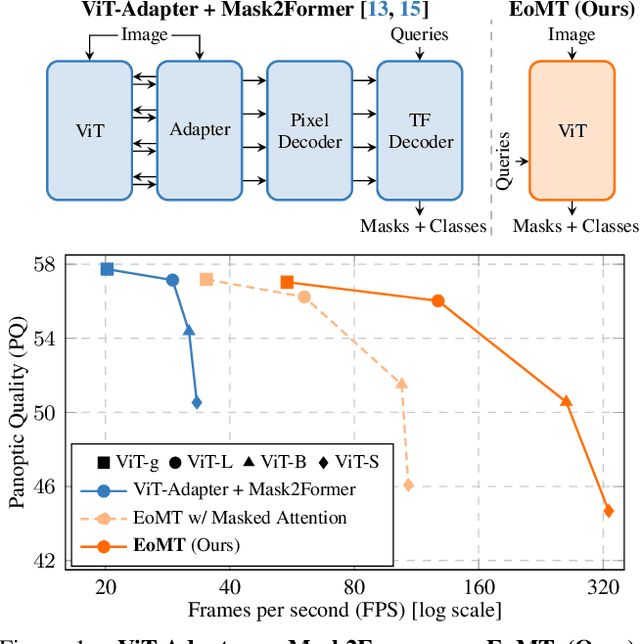
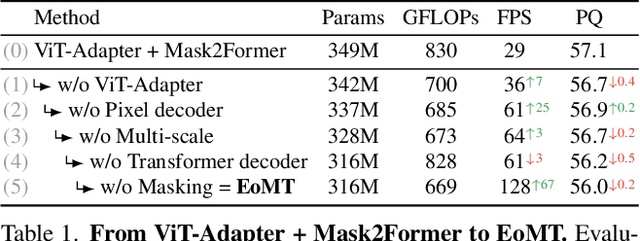
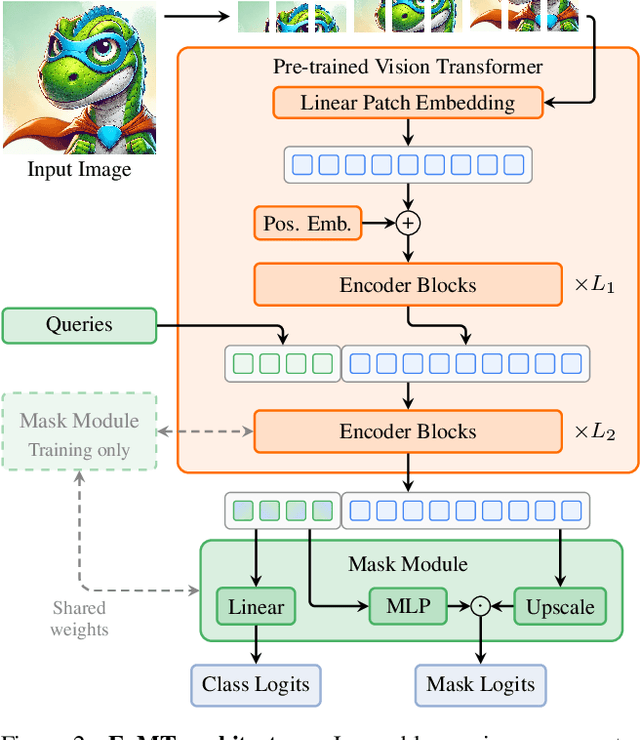
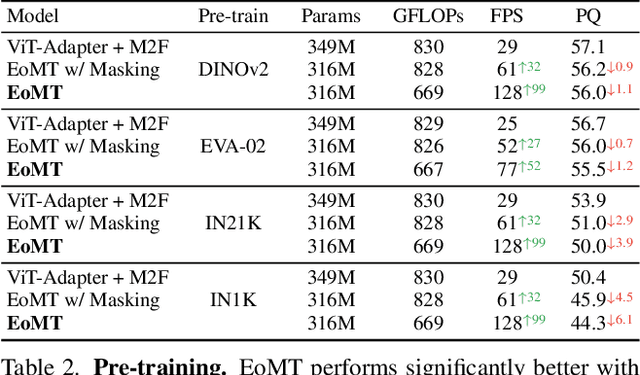
Abstract:Vision Transformers (ViTs) have shown remarkable performance and scalability across various computer vision tasks. To apply single-scale ViTs to image segmentation, existing methods adopt a convolutional adapter to generate multi-scale features, a pixel decoder to fuse these features, and a Transformer decoder that uses the fused features to make predictions. In this paper, we show that the inductive biases introduced by these task-specific components can instead be learned by the ViT itself, given sufficiently large models and extensive pre-training. Based on these findings, we introduce the Encoder-only Mask Transformer (EoMT), which repurposes the plain ViT architecture to conduct image segmentation. With large-scale models and pre-training, EoMT obtains a segmentation accuracy similar to state-of-the-art models that use task-specific components. At the same time, EoMT is significantly faster than these methods due to its architectural simplicity, e.g., up to 4x faster with ViT-L. Across a range of model sizes, EoMT demonstrates an optimal balance between segmentation accuracy and prediction speed, suggesting that compute resources are better spent on scaling the ViT itself rather than adding architectural complexity. Code: https://www.tue-mps.org/eomt/.
A Resource Efficient Fusion Network for Object Detection in Bird's-Eye View using Camera and Raw Radar Data
Nov 20, 2024Abstract:Cameras can be used to perceive the environment around the vehicle, while affordable radar sensors are popular in autonomous driving systems as they can withstand adverse weather conditions unlike cameras. However, radar point clouds are sparser with low azimuth and elevation resolution that lack semantic and structural information of the scenes, resulting in generally lower radar detection performance. In this work, we directly use the raw range-Doppler (RD) spectrum of radar data, thus avoiding radar signal processing. We independently process camera images within the proposed comprehensive image processing pipeline. Specifically, first, we transform the camera images to Bird's-Eye View (BEV) Polar domain and extract the corresponding features with our camera encoder-decoder architecture. The resultant feature maps are fused with Range-Azimuth (RA) features, recovered from the RD spectrum input from the radar decoder to perform object detection. We evaluate our fusion strategy with other existing methods not only in terms of accuracy but also on computational complexity metrics on RADIal dataset.
2024 BRAVO Challenge Track 1 1st Place Report: Evaluating Robustness of Vision Foundation Models for Semantic Segmentation
Sep 25, 2024Abstract:In this report, we present our solution for Track 1 of the 2024 BRAVO Challenge, where a model is trained on Cityscapes and its robustness is evaluated on several out-of-distribution datasets. Our solution leverages the powerful representations learned by vision foundation models, by attaching a simple segmentation decoder to DINOv2 and fine-tuning the entire model. This approach outperforms more complex existing approaches, and achieves 1st place in the challenge. Our code is publicly available at https://github.com/tue-mps/benchmark-vfm-ss.
Exploring the Benefits of Vision Foundation Models for Unsupervised Domain Adaptation
Jun 17, 2024

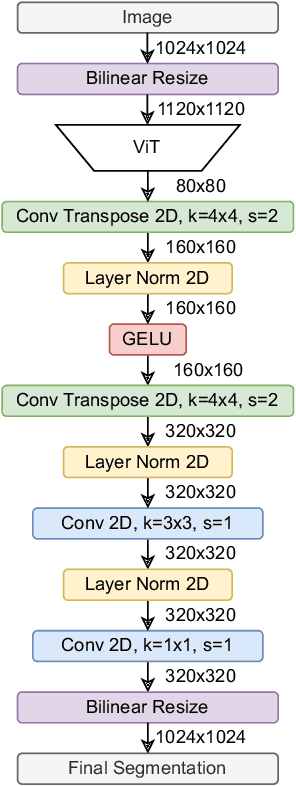

Abstract:Achieving robust generalization across diverse data domains remains a significant challenge in computer vision. This challenge is important in safety-critical applications, where deep-neural-network-based systems must perform reliably under various environmental conditions not seen during training. Our study investigates whether the generalization capabilities of Vision Foundation Models (VFMs) and Unsupervised Domain Adaptation (UDA) methods for the semantic segmentation task are complementary. Results show that combining VFMs with UDA has two main benefits: (a) it allows for better UDA performance while maintaining the out-of-distribution performance of VFMs, and (b) it makes certain time-consuming UDA components redundant, thus enabling significant inference speedups. Specifically, with equivalent model sizes, the resulting VFM-UDA method achieves an 8.4$\times$ speed increase over the prior non-VFM state of the art, while also improving performance by +1.2 mIoU in the UDA setting and by +6.1 mIoU in terms of out-of-distribution generalization. Moreover, when we use a VFM with 3.6$\times$ more parameters, the VFM-UDA approach maintains a 3.3$\times$ speed up, while improving the UDA performance by +3.1 mIoU and the out-of-distribution performance by +10.3 mIoU. These results underscore the significant benefits of combining VFMs with UDA, setting new standards and baselines for Unsupervised Domain Adaptation in semantic segmentation.
ALGM: Adaptive Local-then-Global Token Merging for Efficient Semantic Segmentation with Plain Vision Transformers
Jun 14, 2024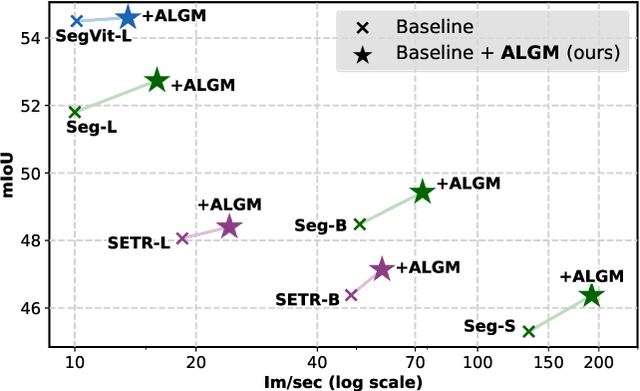
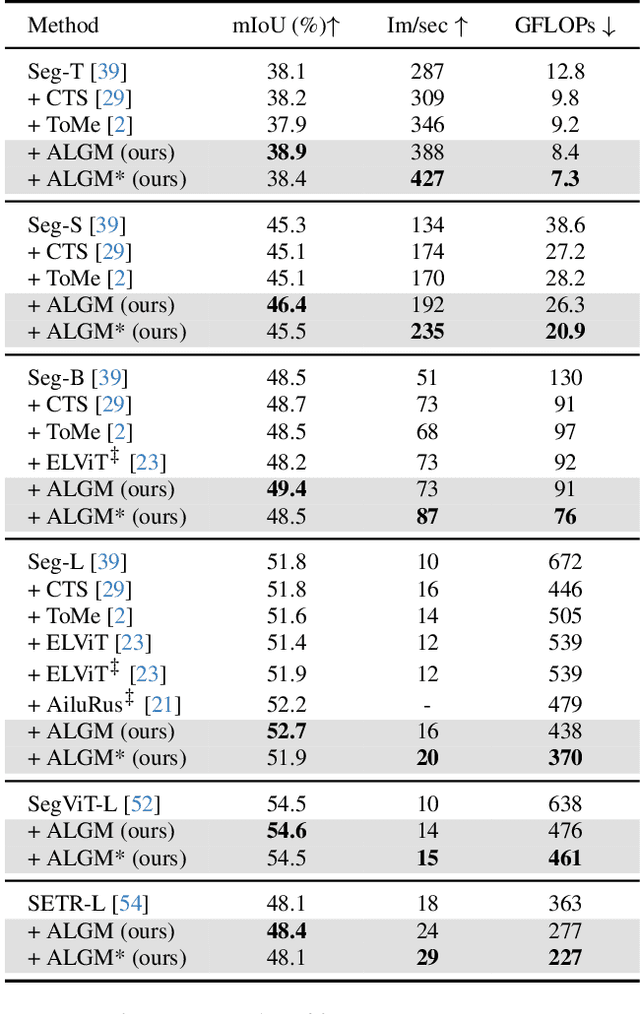
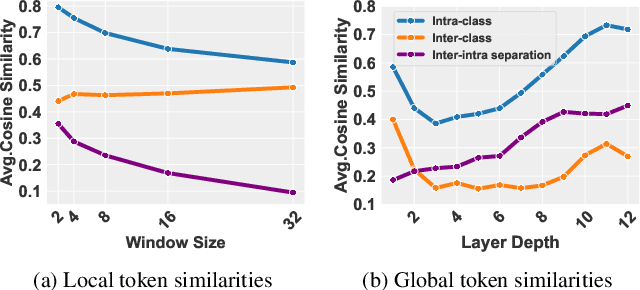

Abstract:This work presents Adaptive Local-then-Global Merging (ALGM), a token reduction method for semantic segmentation networks that use plain Vision Transformers. ALGM merges tokens in two stages: (1) In the first network layer, it merges similar tokens within a small local window and (2) halfway through the network, it merges similar tokens across the entire image. This is motivated by an analysis in which we found that, in those situations, tokens with a high cosine similarity can likely be merged without a drop in segmentation quality. With extensive experiments across multiple datasets and network configurations, we show that ALGM not only significantly improves the throughput by up to 100%, but can also enhance the mean IoU by up to +1.1, thereby achieving a better trade-off between segmentation quality and efficiency than existing methods. Moreover, our approach is adaptive during inference, meaning that the same model can be used for optimal efficiency or accuracy, depending on the application. Code is available at https://tue-mps.github.io/ALGM.
Task-aligned Part-aware Panoptic Segmentation through Joint Object-Part Representations
Jun 14, 2024Abstract:Part-aware panoptic segmentation (PPS) requires (a) that each foreground object and background region in an image is segmented and classified, and (b) that all parts within foreground objects are segmented, classified and linked to their parent object. Existing methods approach PPS by separately conducting object-level and part-level segmentation. However, their part-level predictions are not linked to individual parent objects. Therefore, their learning objective is not aligned with the PPS task objective, which harms the PPS performance. To solve this, and make more accurate PPS predictions, we propose Task-Aligned Part-aware Panoptic Segmentation (TAPPS). This method uses a set of shared queries to jointly predict (a) object-level segments, and (b) the part-level segments within those same objects. As a result, TAPPS learns to predict part-level segments that are linked to individual parent objects, aligning the learning objective with the task objective, and allowing TAPPS to leverage joint object-part representations. With experiments, we show that TAPPS considerably outperforms methods that predict objects and parts separately, and achieves new state-of-the-art PPS results.
How to Benchmark Vision Foundation Models for Semantic Segmentation?
Apr 18, 2024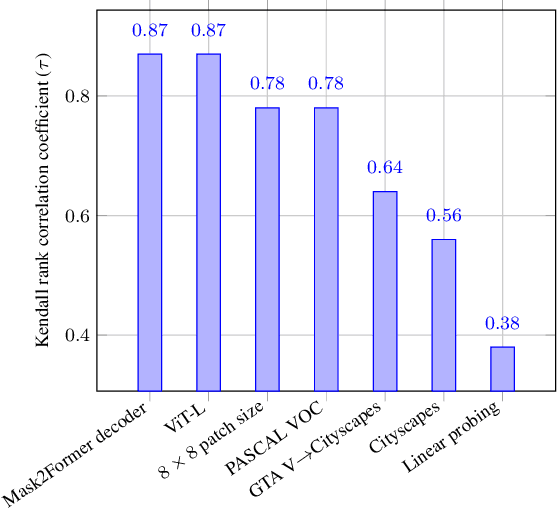


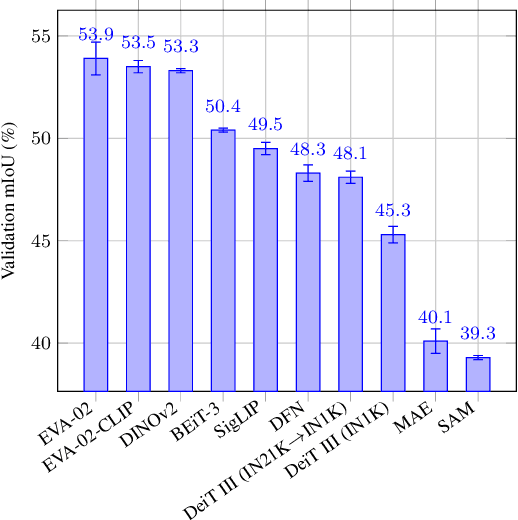
Abstract:Recent vision foundation models (VFMs) have demonstrated proficiency in various tasks but require supervised fine-tuning to perform the task of semantic segmentation effectively. Benchmarking their performance is essential for selecting current models and guiding future model developments for this task. The lack of a standardized benchmark complicates comparisons. Therefore, the primary objective of this paper is to study how VFMs should be benchmarked for semantic segmentation. To do so, various VFMs are fine-tuned under various settings, and the impact of individual settings on the performance ranking and training time is assessed. Based on the results, the recommendation is to fine-tune the ViT-B variants of VFMs with a 16x16 patch size and a linear decoder, as these settings are representative of using a larger model, more advanced decoder and smaller patch size, while reducing training time by more than 13 times. Using multiple datasets for training and evaluation is also recommended, as the performance ranking across datasets and domain shifts varies. Linear probing, a common practice for some VFMs, is not recommended, as it is not representative of end-to-end fine-tuning. The benchmarking setup recommended in this paper enables a performance analysis of VFMs for semantic segmentation. The findings of such an analysis reveal that pretraining with promptable segmentation is not beneficial, whereas masked image modeling (MIM) with abstract representations is crucial, even more important than the type of supervision used. The code for efficiently fine-tuning VFMs for semantic segmentation can be accessed through the project page at: https://tue-mps.github.io/benchmark-vfm-ss/.
Content-aware Token Sharing for Efficient Semantic Segmentation with Vision Transformers
Jun 03, 2023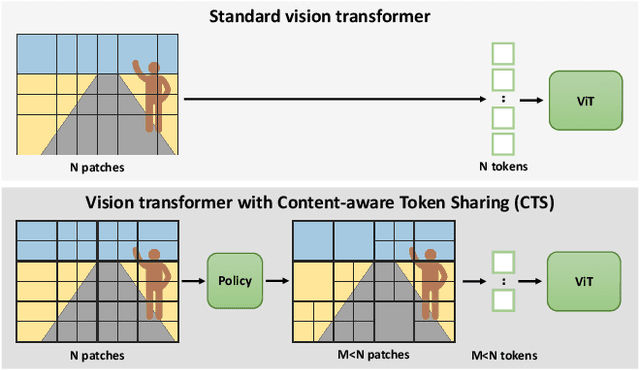
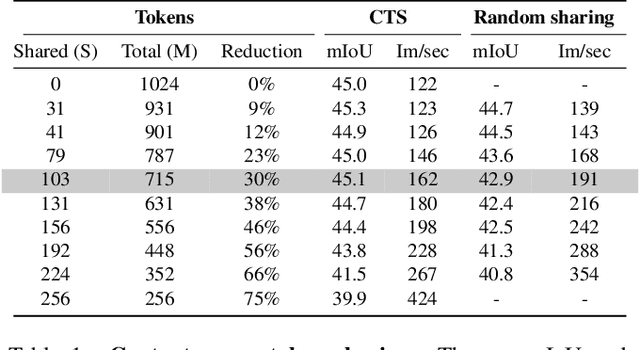
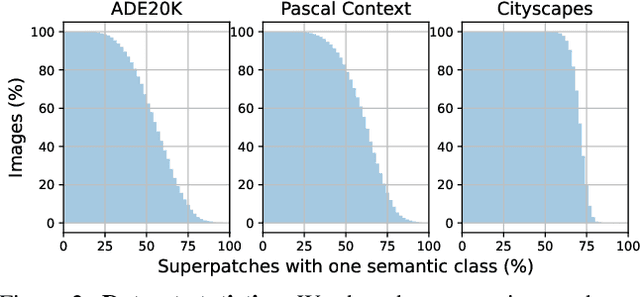
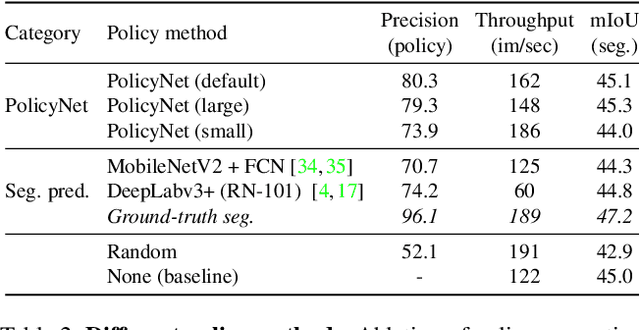
Abstract:This paper introduces Content-aware Token Sharing (CTS), a token reduction approach that improves the computational efficiency of semantic segmentation networks that use Vision Transformers (ViTs). Existing works have proposed token reduction approaches to improve the efficiency of ViT-based image classification networks, but these methods are not directly applicable to semantic segmentation, which we address in this work. We observe that, for semantic segmentation, multiple image patches can share a token if they contain the same semantic class, as they contain redundant information. Our approach leverages this by employing an efficient, class-agnostic policy network that predicts if image patches contain the same semantic class, and lets them share a token if they do. With experiments, we explore the critical design choices of CTS and show its effectiveness on the ADE20K, Pascal Context and Cityscapes datasets, various ViT backbones, and different segmentation decoders. With Content-aware Token Sharing, we are able to reduce the number of processed tokens by up to 44%, without diminishing the segmentation quality.
Intra-Batch Supervision for Panoptic Segmentation on High-Resolution Images
Apr 17, 2023Abstract:Unified panoptic segmentation methods are achieving state-of-the-art results on several datasets. To achieve these results on high-resolution datasets, these methods apply crop-based training. In this work, we find that, although crop-based training is advantageous in general, it also has a harmful side-effect. Specifically, it limits the ability of unified networks to discriminate between large object instances, causing them to make predictions that are confused between multiple instances. To solve this, we propose Intra-Batch Supervision (IBS), which improves a network's ability to discriminate between instances by introducing additional supervision using multiple images from the same batch. We show that, with our IBS, we successfully address the confusion problem and consistently improve the performance of unified networks. For the high-resolution Cityscapes and Mapillary Vistas datasets, we achieve improvements of up to +2.5 on the Panoptic Quality for thing classes, and even more considerable gains of up to +5.8 on both the pixel accuracy and pixel precision, which we identify as better metrics to capture the confusion problem.
 Add to Chrome
Add to Chrome Add to Firefox
Add to Firefox Add to Edge
Add to Edge